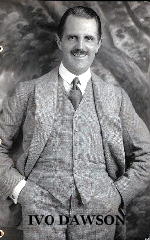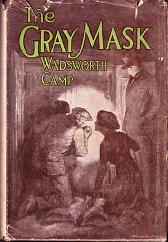Tue 1 Jul 2008
A Review by Mary REED: WADSWORTH CAMP – The Abandoned Room.
Posted by Steve under Authors , Crime Fiction IV , Reviews1 Comment
WADSWORTH CAMP – The Abandoned Room. Doubleday Page & Co., US, hardcover, 1917. Hardcover reprints: W. R. Caldwell: The International Adventure Library, Three Owls Edition, n.d. (this is the edition shown); A. L. Burt, n.d. Jarrolds, UK, hardcover, 1919. Silent film: Jans, 1920, as Love Without Question (scw: Violet Clark; dir: B. A. Rolfe; with Olive Tell as Katherine, James Morrison as Robert Blackburn, Mario Majeroni as Silas Blackburn, and Ivo Dawson as Carlos Paredes, the “Panamanian Sherlock Holmes”).
How was the murder accomplished in a room with both doors locked on the inside and the windows too high for someone to climb in without warning the occupant? Were what one character firmly believed were psychic forces at work in The Abandoned Room?
The Abandoned Room begins with an account of the discovery of the body of Silas Blackburn in that very bedroom, long shunned because of its history of family members dying there from various types of injury to the head. And this death was after Silas had been going around terrified out of his wits, but refusing to say why he was afraid or indeed who or what it was he feared.

Silas is the grandfather of cousins Katherine (who lives with him) and Bobby, who has been having what Camp politely calls a “lively life” in New York and is thus about to be cut out of his grandfather’s will, which otherwise would have left him a million or so with which to be even livelier.
As the story backtracks about 24 hours, Bobby and his good friend, the lawyer Hartley Graham, are talking at their club. Hartley is trying to persuade Bobby to give up his fast ways and go and see his grandfather at The Cedars, a lonely and eerie tumble-down country house.
Bobby agrees to do so but is prevented from catching the vital 12.15 train by a dinner appointment with Carlos Paredes, who brings along theatrical dancer Maria. Lawyer Graham strongly disapproves of Carlos, that “damned Panamanian”, and after reminding Bobby he has to catch his train leaves in disgust.
Next morning Bobby wakes up with his shoes off in a decrepit old house near The Cedars with no recollection of how he got there or indeed anything that happened after his dinner with Carlos and Maria the night before. Ashamed to be seen by his grandfather and cousin in crumpled evening dress and somewhat dazed condition he hoofs it for the railway station to return to New York.
On his way to the station he is met by county detective Howells, who more or less accuses Bobby of doing away with his grandfather in order to prevent the threatened changing of the will. Told to go to The Cedars to await events, Bobby finds his friend Graham already there and not long after Carlos shows up and invites himself to stay. It is a testament to their good breeding they do not tell him to be off although at times the reader will do the job for them.

What follows is a rich stew of events, including strange happenings in the candle-lit dwelling, haunting cries in the surrounding woods and outside the house, suggestions of ghostly presences infesting the decaying mansion, a woman in black glimpsed in the woods, and Bobby’s growing fear he somehow entered the locked room and murdered his grandfather in a drugged haze.
A tightening net of suspicion seems sure to bring him to trial for the crime. When one of his monogrammed hankies is found under the bed in which his grandfather died and his evening shoes fit a footprint under the window, it looks really bad for him — and he cannot summon any memories of the missing hours to his own defence.
My verdict: I really enjoyed this novel and thought the descriptions of the unhappy house and its run down grounds were excellent. The suggested supernatural element is conveyed beautifully, making this a work that would have made a wonderful Hitchcock film, in particular because of a terrific shock near the end when the explanation begins to be revealed.
If nothing else this old dark mansion mystery demonstrates that on the whole monogrammed hankies are probably best avoided. And how was the crime accomplished? The method is prosaic enough, but with a little twist from numerous similar explanations.
Etext: http://www.munseys.com/disktwo/abroomdex.htm
BIBLIOGRAPHY: Taken from Part 19 of the online Addenda to the Revised Crime Fiction IV, by Allen J. Hubin:
CAMP, (CHARLES) WADSWORTH. 1879-1936. Born in Philadelphia PA. A journalist, writer and foreign correspondent whose lungs were said to have been damaged by exposure to mustard gas during World War I. Father of writer Madeleine L’Engle, 1918-2007, q.v. Author of six titles included in the Revised Crime Fiction IV. See below. [Films based on these books are omitted from this entry.]
The Abandoned Room. Doubleday, hc, 1917. Jarrolds, UK, hc, 1919.
The Communicating Door. Doubleday, hc, 1923. Story collection (ghost tales).
-The Forbidden Years. Doubleday, hc, 1930.
The Gray Mask. Doubleday, hc, 1920. SC: Jim Garth. Setting: New York. Collection of seven connected novelets, untitled. “Mystery novel of a detective who falls in love with the chief of police’s daughter.”

The House of Fear. Doubleday, hc, 1916. Hodder, UK, hc, 1917. Setting: New York; theatre. Also published as: Last Warning (Readers Library, 1929).
_The Last Warning. Readers Library, UK, hc, 1929. See: The House of Fear (Doubleday, 1916)
Sinister Island. Dodd Mead, hc, 1915. Setting: Louisiana.
August 11th, 2011 at 9:17 pm
[…] a review by Mary Reed of Camp’s novel, The Abandoned Room, courtesy of The Mystery […]